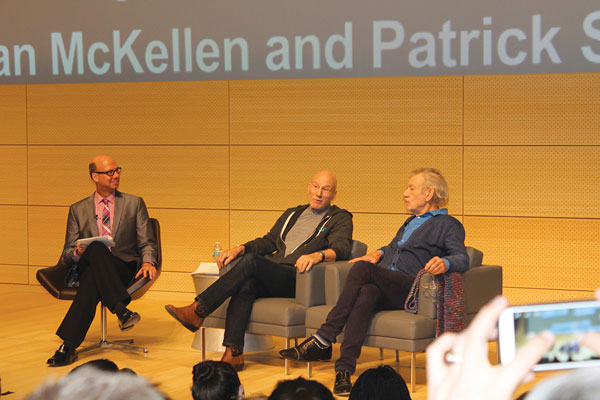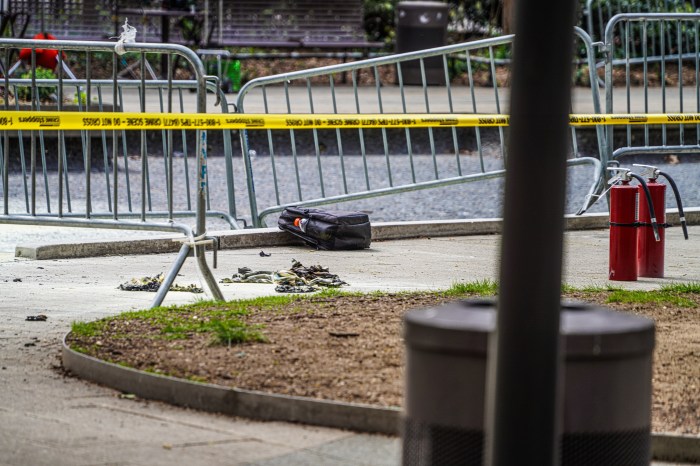
BY LINCOLN ANDERSON | The New School’s new University Center, on Fifth Ave. between 13th and 14th Sts., represents a major step up for the Village school — make that a whole lot of steps up.
The 16-story building’s bottom half — its academic portion — is an airy, window- and light-filled space interconnected by a winding network of wide, gray stairways.
For the renowned, left-leaning Village university, the just-opened $353 million building represents its first true campus, albeit a vertical one.
The most prominent feature of the building’s academic portion is an auditorium with 600 raked seats that can be expanded to 800 by removing walls at its rear. This Tuesday afternoon, the auditorium was jam-packed for a conversation with legendary English actors Patrick Stewart and Ian McKellen moderated by BroadwayWorld.com’s Richard Ridge.
The two thespians recalled their first New York City theater productions back in the day — Stewart’s had been the more successful.
“How things change,” drolly quipped McKellen — currently enjoying worldwide fame as Gandalf in the latest “Hobbit” movie — as the audience laughed warmly.
At the event’s outset, New School President David Van Zandt said of the auditorium, “This is a public venue. We’re going to have many programs here. We want it to be open, not only to the Greenwich Village community, but the whole New York City community.”
It’s one of Downtown’s largest such spaces, he noted.
The theater’s paneling was sustainably built with bamboo. In fact, the entire project is one of the most energy-efficient academic buildings of its type in the nation. Only 35 percent of its exterior is covered by glass windows, helping retain heat. In the classrooms, white panels set beneath rows of narrow horizontal windows reflect light up onto the ceilings, maximizing natural illumination.
The library, formerly in the basement in the New School’s previous building on the site, is now on the seventh floor, where it enjoys windows — and is ringed by a green roof of rainwater- and heat-absorbing sedum. Much of the library’s collection is now electronic.
On the second floor, at “High Line level,” so to speak, is a 200-person student cafeteria overlooking Fifth Ave. There is also a separate faculty and staff lounge.
At several points, the stairways give onto “sky quads,” or open spaces where students can study or congregate. These were already being heavily used Tuesday, only the second day the building had been officially open.
At the top of one stairway is a “social justice hub,” featuring two glass-paneled rooms for student groups’ organizing, plus an open “sky quad.”
The building will feature pieces from The New School’s impressive art collection. On Tuesday, Sylvia Rocciolo and Eric Stark, the co-curators for the building, were strolling about the stairways and spaces considering what might go where. They’ll also be enlisting the help of students in the effort.
In art of another sort, in a nod to the “hands-on” nature of The New School’s programs in fashion and other disciplines, orange and blue spray-painted construction markings have been prominently left on the raw concrete in some spots.
Sitting atop the building’s base is a 600-bed student dorm, which is not all freshmen, but a mix.
In general, the area in front of the building and the lobby were full of an exhilirating bustle of activity, with students and faculty going in and out of the building’s multiple doors. Many were catching cigarette breaks in front of the building, and dressed in black.
The building design first proposed was a 500,000-square-foot monolithic slab. But, in the face of community pressure, the project — designed by Roger Duffy of SOM architects —was cut back to 375,000 square feet, with setbacks added in the formerly sheer walls.
While he often clashed with the school’s progressive student body and faculty during a tumultuous tenure as president, Bob Kerrey, Van Zandt’s predecessor, was a phenomenal fundraiser, and New School officials admit the new building wouldn’t have been built without him.

















